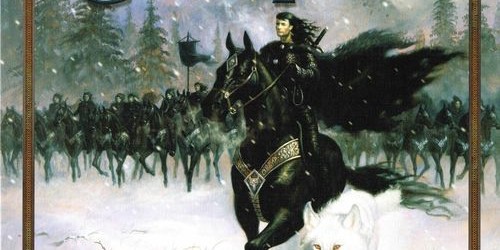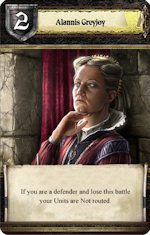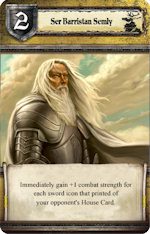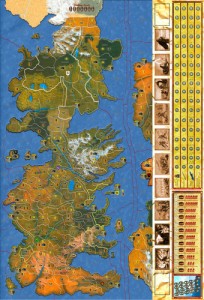By Fred Manzo
A Game of Thrones
A few months ago we played the first edition of A Game of Thrones. It was designed by Christian T Petersen and Kevin Wilson and published in 2003 by Fantasy Flight Games. We also used its Clash of Kings expansion, which allowed for 6 players and included a game-board overlay. Basically, we are talking about an area movement game with order tokens and a semi-random turn sequence. Although cards are included, it is not a Card Driven Game (CDG) in the traditional meaning of that term.
While this was only my second time playing, a few of the regulars had played it multiple times. Think of it as a combination of Strike of the Eagle with its hidden orders and Diplomacy, due to its power politics and back stabbing. But Strike of the Eagle is approximately 100 times more exciting.
I believe this games basic problem, at least with this first edition, was something quite common with license games: not enough development. At least to me, it’s clear A Game of Thrones simply never received the number of play-test sessions it deserved.
First it was looooooong. We took about 6 hours for a 10 turn game and second it was slooooooow. Just about every piece moved ONE space, except that fleets could act as bridging units AND transport ground forces at warp speed by handing off their passengers from one ship to the next in a Conga line without actually moving themselves. I guess they had mastered the art of transferring passengers from ship to ship on the open sea en masse.
But, not only is this mechanism gamey, strangely enough, it does little to enhance game play. First, it still takes hours to set up the Conga line when the ships who make it up move at such a slow pace and, second, it signals to your opponents what you are planning to do once it is established. Thus saddling you with a strategy that is both slow to execute and obvious to boot.
And when I said pieces moved one space, let me explain that was the maximum they moved, not the minimum. As players only had 2 or 3 move orders and controlled say 5 or 6 areas, most of their units never got to move at all in a turn. So allowing units to move one space would be an improvement. And remember, there were 6 players in the game and you are only next to one or two of them at a time. So while many of your troops never got to move, neither did most of your neighbor’s forces. Then both of you sat around for another hour waiting for almost all the troops you were interested in, not moving again.
Although, perhaps counter-initiatively, the overall situation was still MUCH too random. For example, mustering of new units did not occur at the end of a turn as is standard in these types of games; instead it came up when a card appeared, which was only every now and then. Usually then. Of course, without a dependable re-supply schedule players were even more leery of risking the few troops they had.
And if all this wasn’t bad enough, for some reason a supply system was included, which made movement still harder. Did I mention the game was slow?
Plus, the hidden orders could only be placed one to an area, so even if you wanted to risk your few troops, there were usually more important considerations to take into account.
For example, if the fighting is between two coalitions and your holdings are positioned on a map edge, it might theoretically take you an hour and a half of playing time just to get to the frontlines. But you’d never risk doing such a thing because whoever you sent off couldn’t be depended upon to get back in time to defend your home castle if things went wrong. Remember most of your troops are lucky to move one space a turn. So you normally tend to do nothing in situations like this.
As a result, a typical player usually finds himself limited to controlling a few precious troops, that can’t or won’t move much beyond his few precious areas and are usually out of position to affect the over-all strategic situation anyway.
As for re-play value, the map is basically long and somewhat thin, so, at least in our games, it tended to break down into a north vs. south contest. So, while a game might be interesting the first time through, replay value suffers due to having, in effect, two mobs fighting it out in a hallway. How different can each game be? And how interesting is it to be the guy in the middle or at either end?
Now, most of these problems didn’t have to be this way. The game does have some interesting mechanics and I’ve heard that the second edition improves things. But really did anyone play-test this? Apparently no one noticed they had a 6 hour Euro, with limited re-play value and no excitement. Harvey mentioned he was thinking of creating a variant in an effort to make this game work. Here’s hoping he succeeds.
Game Resources:
A Game of Thrones rules summary












